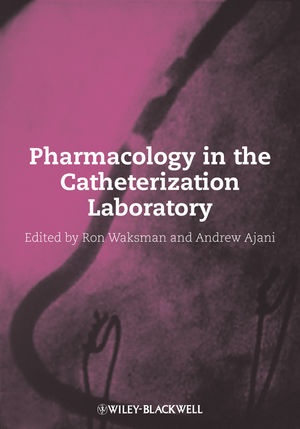Pharmacology in the Catheterization LaboratoryISBN: 978-1-4051-5704-9
Hardcover
400 pages
December 2009, Wiley-Blackwell
 |
||||||
0.0 Elective PCI.
0.1 Optimal antithrombotic therapy.
0.1.1 Unfractionated heparin and ACT monitoring.
0.1.2 Alternative to unfractionated heparin.
0.1.2.1 LMWH.
0.1.2.2 direct thrombin inhibitor (bivarlirudin).
0.1.2.3 direct Xa antagonist (fondaparinux).
0.2 Optimal antiplatelet therapy.
0.2.1 Dual aspirin and thienopyridine therapy.
- pre-treatment and dose.
0.2.2 When to use GP2B3A inhibitor and which one to use.
- abciximab, tirofiban, eptifibatide.
0.2.3 Duration of Antiplatelet therapy with drug-eluting vs. bare-metal stents.
1.0 High risk PCI.
1.1 ACS (non ST elevation).
1.1.1 Upstream GP2B3A inhibitors.
1.1.2 Timing, loading dose and duration of clopidogrel therapy.
1.2 Diabetes mellitus.
1.2.1 Peri-procedural management.
1.3 Renal dysfunction.
1.3.1 Renal protective agents.
- IV hydration, N-acetylcysteine, bicarbonate, fenoldopam.
- Timing, route of administration and duration.
1.3.2 Radiocontrast induced nephropathy.
1.3.2.1 Ideal contrast agent.
1.3.3 Additional risk with other medications.
- ACE inhibitors, NSAIDS, hypotensive medications (e.g. nitrates, BBlockers).
1.4 Cardiogenic shock.
1.4.1 Inotropic support.
- adrenaline, noradrenaline, dopamine, dobutamine, milrinone, levosimendan, metaraminol.
- summary of when to use which agent (ref. ACC/AHA STEMI guidelines).
1.4.2 Anticoagulation support for mechanical devices.
- IABP, LVAD, Tandem Heart, Impaler etc.
2.0 Acute STEMI PCI.
2.1 Primary.
- summary of optimal anticoagulation, GP2B3A, antiplatelet therapy (aspirin, clopidogrel).
2.2 Rescue.
- summary of optimal anticoagulation, GP2B3A, antiplatelet therapy (aspirin, clopidogrel).
2.3 Facilitated.
- summary of optimal anticoagulation, GP2B3A and lytic combinations in recent trials.
2.4 Adjunctive therapies.
2.4.1 GIK (glucose-insulin-potassium).
2.4.2 Complement inhibitor (Pexiluzimab).
2.4.3 Intracoronary vs. intravenous GP2B3A inhibitor.
2.4.4 High dose tirofiban.
(Standard dose GP2B3A inhibitors for STEMI discussed in 2.1 and 2.2).
3.0 Optimal thrombolytic therapy (as primary therapy for STEMI).
- alteplase, reteplase, streptokinase, or tenecteplase.
4.0 Special considerations in PCI.
4.1 Coronary spasm.
4.2 No reflow phenomenon.
- IV GTN, GP2B3A inhibitor, nitroprusside, adenosine, verapamil, nicorandil.
4.3 Agents to optimise access of radial artery approach (i.e. nitrates, verapamil).
4.4 Arrhythmia Management.
4.4.1 Tachyarrhythmias management.
- IV lignocaine, amiodarone, etc.
4.4.2 Bradyarrhythmias management.
- IV atropine, adrenalin, indications for temporary pacing wire.
4.5 Coronary perforations.
4.5.1 Reversal of anticoagulation.
- protamine.
4.5.2 Platelet and transfusion of blood products.
4.6 Oral anticoagulation issues in PCI.
4.6.1 Management of patients on anticoagulation undergoing diagnostic catheterisation and PCI.
- prosthetic heart valves, AF and other indications.
- use of UFH and LMWH as bridging therapy.
- when to restart oral anticoagulation post procedure.
4.6.2 Indications for anticoagulation post PCI.
- LV thrombus.
- large anterior myocardial infarction.
- triple (aspirin, clopidogrel and warfarin) vs. dual therapy.
4.7 Role of Antibiotic prophylaxis in PCI.
5.0 Post procedural pharmacotherapy.
5.1 Role of statins, beta-blocker, ACE inhibitors, aldosterone antagonist (epleronone).
5.1.1 ACS (include STEMI/NSTEMI).
5.1.2 Elective PCI.
6.0 Special considerations with antiplatelet therapy.
6.1 Antiplatelet therapy resistance: definition, diagnosis and clinical implications.
6.2 Potential drug-drug interactions.
6.2.1 Clopidogrel and statins.
6.2.2 Aspirin and ibuprofen.
6.2.3 COX-2 inhibitors in patients with coronary artery disease.
6.3 Clopidogrel use in patients requiring CABGS.
6.4 Thrombocytopenia post PCI.
6.4.1 HITTS.
6.4.2 GP2B3A risk.
6.5 Novel antiplatelet therapy.
- Prasugrel etc.
7.0 Pharmacotherapy for in-stent restenosis.
7.1 Drug-eluting stents.
7.1.1 Sirolimus.
7.1.2 Paclitaxel.
7.1.3 Other agents (ABT-578).
7.1.4 Oral agents to prevent ISR (Oral Sirolimus, Glitazones).
8.0 Novel pharmacotherapy and PCI.
APPENDIX.
- Listing of generic drug names in alphabetical order with 1 page summary sheet on each drug.
o Indications and contraindications.
o Dose and formulations.
o Adverse reactions.
o Drug interactions



